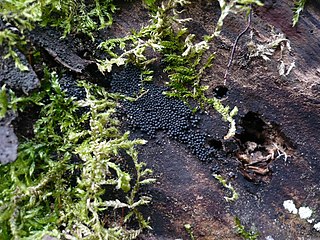Related Research Articles

Dothideomycetes is the largest and most diverse class of ascomycete fungi. It comprises 11 orders 90 families, 1300 genera and over 19,000 known species. Traditionally, most of its members were included in the loculoascomycetes, which is not part of the currently accepted classification. This indicates that several traditional morphological features in the class are not unique and DNA sequence comparisons are important to define the class.

The Pleosporales is the largest order in the fungal class Dothideomycetes. By a 2008 estimate it contains 23 families, 332 genera and more than 4700 species. The majority of species are saprobes on decaying plant material in fresh water, marine, or terrestrial environments, but several species are also associated with living plants as parasites, epiphytes or endophytes. The best studied species cause plant diseases on important agricultural crops e.g. Cochliobolus heterostrophus, causing southern corn leaf blight on maize, Phaeosphaeria nodorum causing glume blotch on wheat and Leptosphaeria maculans causing a stem canker on cabbage crops (Brassica). Some species of Pleosporales occur on animal dung and a small number occur as lichens and rock-inhabiting fungi.

Dothideomycetidae is a subclass of Dothideomycetes consisting of three orders: Dothideales, Myriangiales and Capnodiales. The cavities of the sexual structures do not have vertical cells growing between the sac-like cells bearing the sexual spores (asci).

Pleosporomycetidae is a subclass of Dothideomycetes consisting of four orders: Pleosporales, Hysteriales, Mytilinidiales, and Jahnulales. One of its defining features is the presence of pseudoparaphyses. These are sterile cells extending down from the upper portion of the cavity inside sexual structures containing the sac-like asci with sexually produced spores (ascospores). Pseudoparaphyses are initially attached at both their ends, but sometimes the upper part may become free. Some orders and families where these cells are present remain outside the subclass since DNA based phylogenies cannot place them with confidence. However they could conceivably be included within Pleosporomycetidae in future.

The Hysteriaceae are a taxonomic family of fungi and the only extant family of the order Hysteriales. Members of the Hysteriaceae are defined by the possession of a sexual structure called the hysterothecium, an elongated structure that opens by a longitudinal slit and releases sexually produced spores. The family is widely distributed, with many species found in temperate regions, and most are saprobic on wood and bark, although a few are parasitic on plants.

Lophiostoma is a genus of ascomycetous fungi in the family Lophiostomataceae.
Belizeana is a genus of fungi in the class Dothideomycetes. The relationship of this taxon to other taxa within the class is unknown. This is a monotypic genus, consisting of the single species Belizeana tuberculata.
Catulus is a genus of fungi in the class Dothideomycetes. The relationship of this taxon to other taxa within the class is unknown. A monotypic genus, it contains the single species Catulus aquilonius.
Flavobathelium is a genus of fungi in the class Dothideomycetes. The relationship of this taxon to other taxa within the class is unknown. A monotypic genus, it contains the single species Flavobathelium epiphyllum.
Dolabra is a genus of fungi in the class Dothideomycetes. The relationship of this taxon to other taxa within the class is unknown. A monotypic genus, it contains the single species Dolabra nepheliae.
Cyrtopsis is a genus of fungi in the class Dothideomycetes. The relationship of this taxon to other taxa within the class is unknown. A monotypic genus, it contains the single species Cyrtopsis fumosa.
Heterosphaeriopsis is a genus of fungi in the class Dothideomycetes. The relationship of this taxon to other taxa within the class is unknown. A monotypic genus, it contains the single species Heterosphaeriopsis fulvodisca.
Grandigallia is a genus of fungi in the class Dothideomycetes. The relationship of this taxon to other taxa within the class is unknown. A monotypic genus, it contains the single species Grandigallia dictyospora.
Lophiosphaerella is a genus of fungi in the class Dothideomycetes. The relationship of this taxon to other taxa within the class is unknown. Also, the placement of this genus within the Dothideomycetes is uncertain. A monotypic genus, it contains the single species Lophiosphaerella euryae.
Comesella is a genus of fungi in the class Dothideomycetes. The relationship of this taxon to other taxa within the class is unknown. Also, the placement of this genus within the Dothideomycetes is uncertain. A monotypic genus, it contains the single species Comesella anomala.
Cyrtidium is a genus of fungi in the class Dothideomycetes. The relationship of this taxon to other taxa within the class is unknown. Also, the placement of this genus within the Dothideomycetes is uncertain. A monotypic genus, it contains the single species Cyrtidium naevium.
Gloeodiscus is a genus of fungi in the class Dothideomycetes. The relationship of this taxon to other taxa within the class is unknown. Also, the placement of this genus within the Dothideomycetes is uncertain. A monotypic genus, it contains the single species Gloeodiscus nigrorufus.

Ruzenia is a genus of fungi in the Helminthosphaeriaceae family of the Ascomycota. The relationship of this taxon to other taxa within the Sordariomycetes class is unknown, and it has not yet been placed with certainty into any order. This is a monotypic genus, containing the single species Ruzenia spermoides.
The Myriangiaceae are a family of fungi in the Ascomycota, class Dothideomycetes. Species in this family have a widespread distribution, and are typically found associated with scale insects. The family occupies an isolated phylogenetic position within the Dothideomycetes.

Mytilinidiales is an order of fungi within the class Dothideomycetes.
References
- ↑ Mugambi GK, Huhndorf SM, 2009. Parallel evolution of hysterothecial ascomata in ascolocularous fungi (Ascomycota, Fungi). Systematics and Biodiversity 7: 453–464.
- ↑ Boehm EW, Mugambi GK, Miller AN, Huhndorf SM, Marincowitz S, Spatafora JW, Schoch CL, 2009. A molecular phylogenetic reappraisal of the Hysteriaceae, Mytilinidiaceae and Gloniaceae (Pleosporomycetidae, Dothideomycetes) with keys to world species. Studies in Mycology 64: 49-83S43.